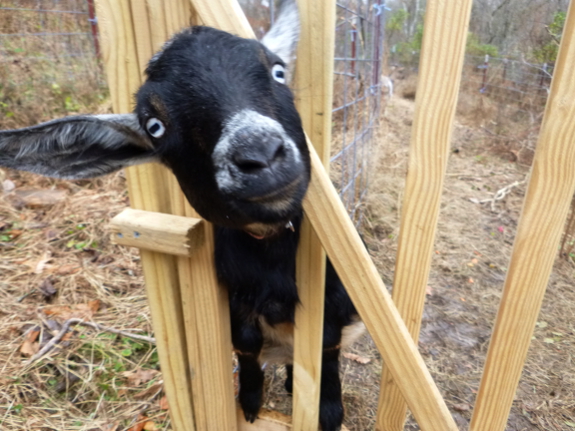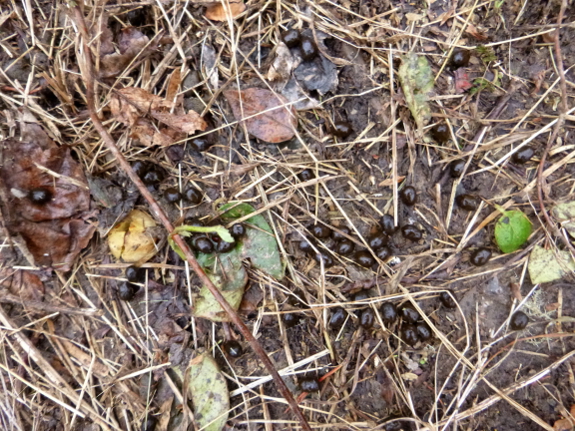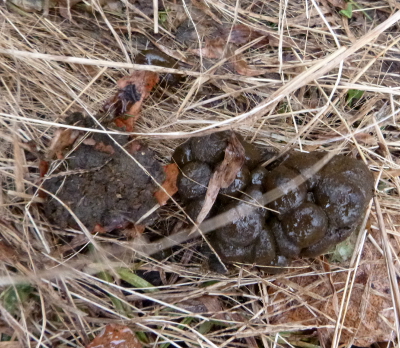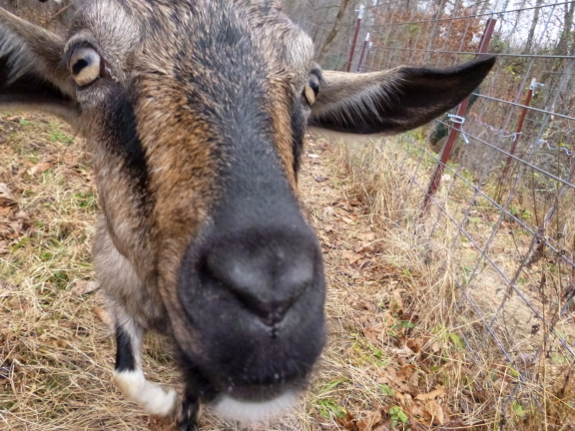
Goat manure

Guess what? It's time to
talk about poop! I'm sure you're excited...and if not, you can just look
at the cute snapshot of Artemesia and then move along.

When you start reading
goat books and websites, you'll soon run across mention of "goat
berries." I guess the cute euphemism is meant to make up for the fact
that goat keepers spend a lot of time thinking about manure...and not
just about how well that manure will incorporate into their gardens.
 Over
a decade ago, a naturalist once told me that clumps of deer manure like
the photo shown to to the left were a sign that the deer in question
was a buck. Wrong! If deer are anything like goats (and the two species
do seem to be remarkably similar), manure that clumps instead of
separating into individual berries is an early warning sign. I notice a
few clumps every time I get lazy and let our girls dine solely on hay
for a few days, then allow them to gorge on oat leaves when their guts
have lost some of their acclimation to the greenery. The clumpy manure
tells me to be a bit more careful, to feed oat leaves every day in
moderation rather than expecting the caprine gut to change on a dime.
(Still, as long as I just see one clump and a lot of berries, I don't
worry much.)
Over
a decade ago, a naturalist once told me that clumps of deer manure like
the photo shown to to the left were a sign that the deer in question
was a buck. Wrong! If deer are anything like goats (and the two species
do seem to be remarkably similar), manure that clumps instead of
separating into individual berries is an early warning sign. I notice a
few clumps every time I get lazy and let our girls dine solely on hay
for a few days, then allow them to gorge on oat leaves when their guts
have lost some of their acclimation to the greenery. The clumpy manure
tells me to be a bit more careful, to feed oat leaves every day in
moderation rather than expecting the caprine gut to change on a dime.
(Still, as long as I just see one clump and a lot of berries, I don't
worry much.)
Clumpy manure can also be
a sign of worms, but that doesn't seem to be the case in our situation
since I only see a clump occasionally, and only after their feeding
regimen has abruptly changed. Still, the worm potential is worth noting
since intestinal parasites are such a big deal with goats.

Speaking of the health
issues associated with goat manure, I should mention that I've been
letting our girls spend most of their time in the same pasture for the
last couple of weeks. While lack of pasture rotation is generally a very
bad idea with goats, this pen is more a spot for our girls to run
around in between dipping into the hay trough and talking a walk with me
to honeysuckle patches rather than a spot to dine.
Still, manure is
beginning to build up on the ground, which could be a health hazard if
the goats got hungry and nibbled at the low grass. (Unlikely given their
as-much-hay-as-they-can-eat diet combined with a very finicky nature.)
On the other hand, I like to think of goat manure feeding this poor
soil, so rather than moving the goats to a new spot, I'll probably
spread some straw over the current manure load and turn this patch into a
bit of an exterior deep-bedding zone. The goats get to keep running
around right outside their coop door, while the soil gets to slurp up
the high-quality manure --- a win-win.
That should work until we get our electric fence finished. At which point our girls will be spending more time rustling up their own grub...rather than watching me carry their hay in from the parking area half a bale at a time. Good thing two small goats eat less than a bale between them every week....
Want more in-depth information? Browse through our books.
Or explore more posts by date or by subject.
About us: Anna Hess and Mark Hamilton spent over a decade living self-sufficiently in the mountains of Virginia before moving north to start over from scratch in the foothills of Ohio. They've experimented with permaculture, no-till gardening, trailersteading, home-based microbusinesses and much more, writing about their adventures in both blogs and books.
Want to be notified when new comments are posted on this page? Click on the RSS button after you add a comment to subscribe to the comment feed, or simply check the box beside "email replies to me" while writing your comment.

Hi Anna and Mark,
That was going to be my question:
Mom --- Goats seem to have much weaker stomachs than dogs, so they're very, very careful not to eat anything that could ever have touched poop. If they drop a piece of apple on the ground, they won't even pick it up!
John --- You can read about the goat minerals we offer our girls here. That said, they haven't seemed very interested in any of the offerings yet, even though I run my fingers through the dishes every few days so they'll feel more fresh.
Pregnant and milking does will also need some concentrates, which we're being a bit hit-or-miss about at the moment. For the last couple of weeks, I've been giving the girls two or three apple cores, one carrot, and about a quarter of a cup of sunflower seeds between them as a morning ration. Abigail gets about two thirds of it since she butts Artemesia away as soon as she finishes her own dish full. That said, on warm days, they don't even want that much, so I have to learn to cut back based on the weather.
Hi Anna,
The recent Acres has a "doc" Holliday piece: "Let Your Animals Teach You Nutrition". The article talks about 4 choices and their abcplus.biz website talks about 12.
I would guess your girls are getting what they need if they are leaving your minerals alone.
That article while short was a worthwhile read.